Binomial distribution (Intro to statistics)
- Let us start with the definition of a function to simulate the tossing of a coin.
sim_binom<- function(how_many_tosses, how_many_samples){
results <- c()
heads_or_tails <- c(1, 2)
for(i in 1:how_many_samples){
tosses <- sample(heads_or_tails, how_many_tosses, replace = TRUE)
count <- 0
for(j in tosses){
if(j == 1){
count = count+1
}
results[i] <- count/how_many_tosses
}
}
return(hist(results, breaks = c(50)))
}
- The simulations below will toss a fair coin N number of times and calculate the percentage of heads that appeared in our simulation. This process will be repeated X times.
sim_binom(10, 10) #Throwing the coin 10 times, and repeating the process 10 times.
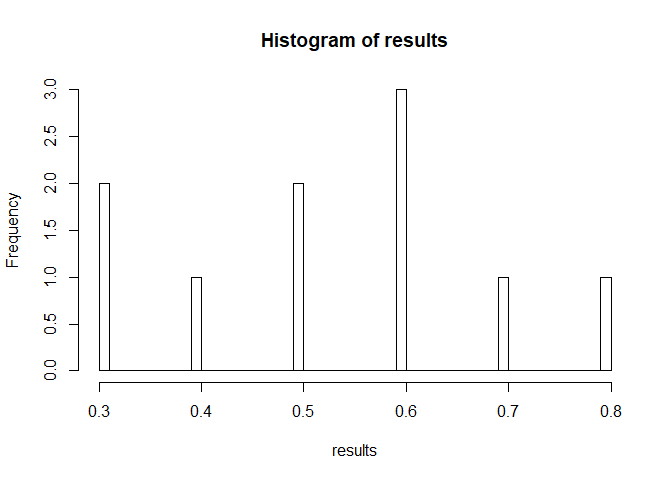
sim_binom(100, 100) #Throwing the coin 100 times, and repeating the process 100 times.

sim_binom(1000, 1000) #Throwing the coin 1000 times, and repeating the process 1000 times.
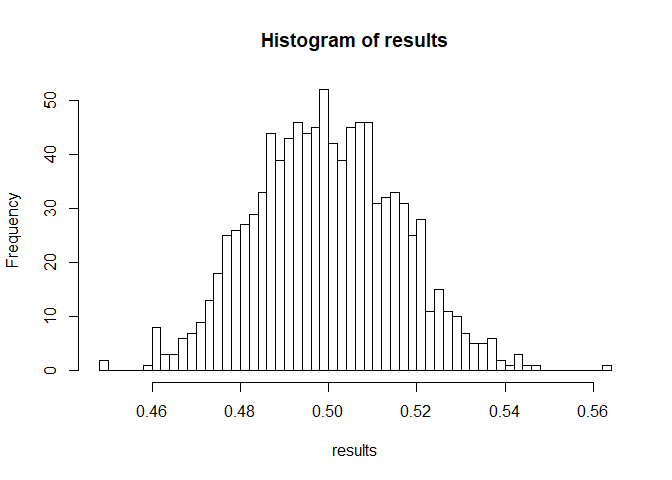
- Just a little help interpreting the histograms
The x axis indicates the percentage of heads that you got from tossing the coin N times. The Y axis represents how many times this event occurred. For instance, running the last simulation above, you will probably see that in ‘most’ of the cases you get something around 50% of heads and 50% of tails, which is expected from a fair coin.
-
Compare each one of the three simulations above and answer the following questions:
-
As the number of tosses increases, what do you observe from the #histogram?
-
For the last simulation with 1000 tosses, where are most cases centered at?
-
Does the shape of the histogram remind you of any distribution we have studied so far? Which one and why?
##Section 2
- Imagine we do not have a fair coin and we want to calculate the probability of gettig exactly 2 heads out of 6 tosses.
p_of_heads = 0.7
p_of_tails = 0.3
- There are many possibilities for getting 2 heads out of 6 tosses (e.g. HHTTTT, HTHTTT…). The probability of only one of these cases ocurring is:
prob <- (p_of_heads^2) * (p_of_tails^4)
- But we have to multiply it by the number of times it can happen by tossing the coin 6 times. We calculate this by applying the combinatorial formula below:
combinatorial_possibilities = factorial(6) / (factorial(2)*factorial(4))
- Now answering the questions: what is the probability of getting 2 successess in 6 attempts? Our final answer would be:
combinatorial_possibilities*prob
-
Try this one by yourself:
-
A basketball player has a 50% chance of scoring a point. If he throws the ball 6 times, what is the probability that he will get exactly 0, 1, 2, 3, 4, 5 and 6 points?
-
Before calculating, let R help us a little bit and let us define a function for calculating the probabilities:
binomial_calculator <- function(number_of_throws, p_win, p_lose, number_of_wins){
prob <- (p_win^number_of_wins) * (p_lose^(number_of_throws-number_of_wins))
combinatorial_possibilities = factorial(number_of_throws) / ( factorial(number_of_wins)*factorial((number_of_throws-number_of_wins)) )
probability = combinatorial_possibilities*prob
return(probability)
}
- Calculating responses:
p_0 = binomial_calculator(6, 0.5, 0.5, 0) #0
p_1 = binomial_calculator(6, 0.5, 0.5, 1) #1
p_2 = binomial_calculator(6, 0.5, 0.5, 2) #2
p_3 = binomial_calculator(6, 0.5, 0.5, 3) #3
p_4 = binomial_calculator(6, 0.5, 0.5, 4) #4
p_5 = binomial_calculator(6, 0.5, 0.5, 5) #5
p_6 = binomial_calculator(6, 0.5, 0.5, 6) #6
- Here is how we can interpret it: If the basketball player had an equal probability of missing and losing, by throwing a ball 6 times, we would expect him to get exactly 4 points (theoretically speaking). And the more he departed from this number of points, the more we would think that he does not have a 50% chance of missing. For instance, the probability of him getting exactly 0 points out of 6 throws, assuming an equal probability of scoring, would be as low as:
p_0
## [1] 0.015625
- Now let us visualize what these probabilities look like:
plot(c(p_0, p_1, p_2, p_3, p_4, p_5, p_6))
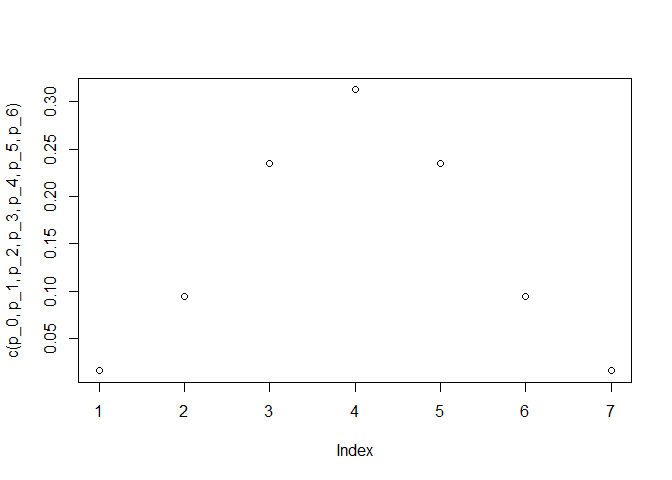
-
Again, does this plot remind you of any distribution? Which one and why?
-
The plots below are showing you the probabilities of getting any number of heads from 0 to 10, 100, and 1000, assuming that we flipped a fair coin. It basically does the same thing we did before, but with larger sample sizes.
plot( c(dbinom(0:10, 10, 1/2)), col = 'red' )
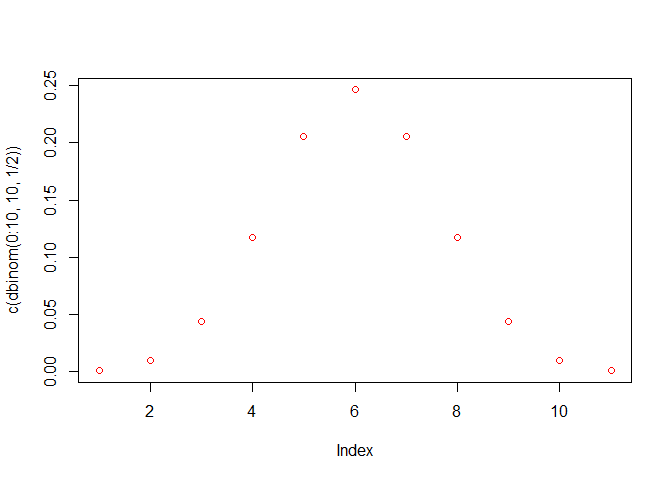
plot( c(dbinom(0:100, 100, 1/2)), col = 'green', xlim = c(39, 65))

plot( c(dbinom(0:1000, 1000, 1/2)), col = 'blue', xlim = c(460, 545))
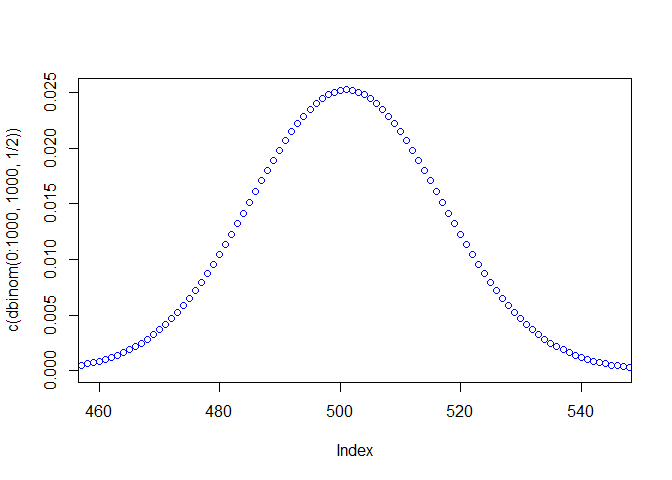
- Does that make sense to you? Look at the first graph and answer: *Why is it less probable to get 1 head out of 10 tosses than getting 5 heads out of 10 tosses?